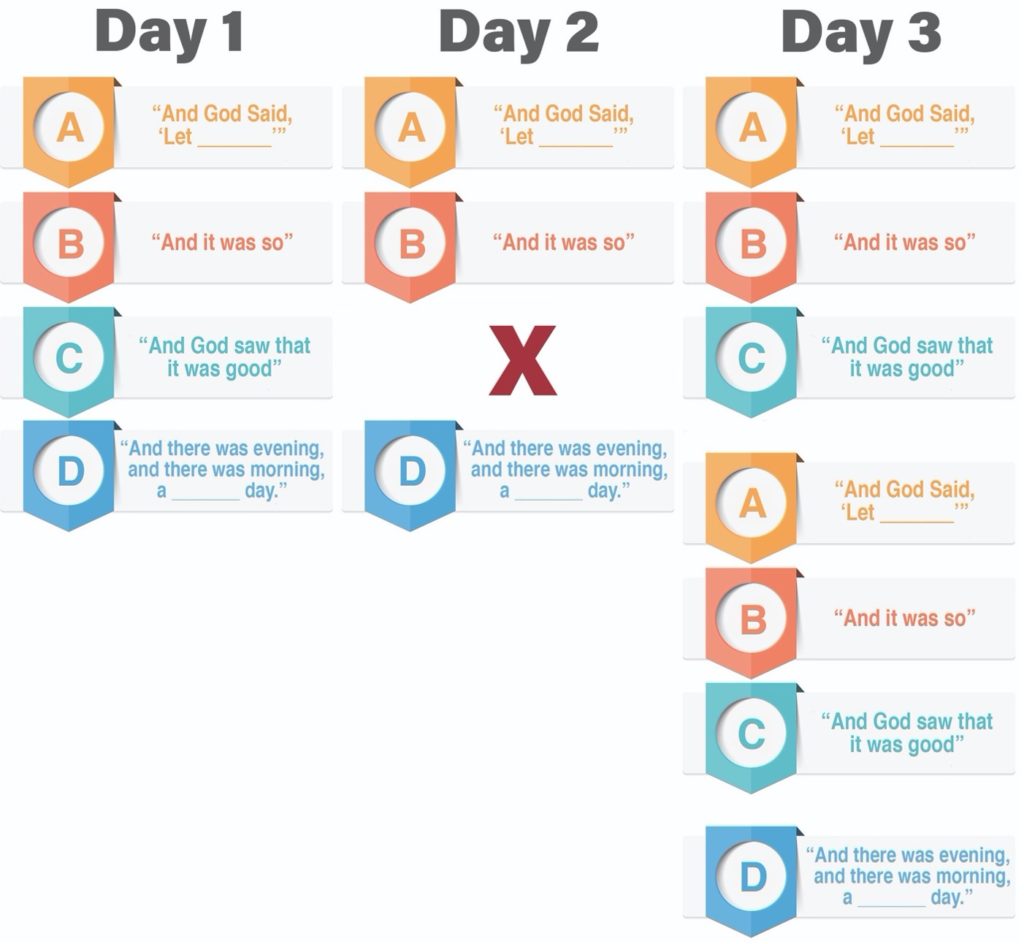Were the Days of Creation 24 Hours Long? An In-Depth Look at Genesis 1-2

The Structure of Genesis 1
Genesis 1 is a structural masterpiece. The intentionality Moses gives to crafting it is quite astounding. So, let’s start by looking at the overarching arrangement of this account and consider what Moses is meaning to convey through it. Were the days of creation 24 hours long? Let’s dive in.
Repeated Phrases
The bones of the narrative that hold it all together are a series of repeated phrases. Let me outline them below labeling them A, B, C, and D.

These phrases are repeated for each of the first six days of creation. What is interesting, however, is that the first three days all follow a slightly different pattern: Day 1 establishes the basic ABCD pattern; Day 2 removes one of the phrases (phrase C); Day 3 states ABC twice before concluding with D. You can see this in the chart below.

It gets even more interesting as we go on, for the same unique pattern of days 1-3 get repeated in days 4-6. You can see this in the chart below.

It is pretty amazing when you zoom out and discover Moses’ parallel arrangement of these phrases. But it is not just for “literary aesthetics” or to make the story “look pretty” that he crafts it in this way; Moses uses the structure to highlight how the events of each day are related to each other and together have theological significance for us today.
Let me display some of the main thematic parallels in the chart below. I have numbered these according to their days. Days 3 and 6 include two parts since God gives two creative pronouncements on these days.

You may also have noticed an internal similarity between days 1-3 and days 4-6. On days 1-3 we are told of God dividing and forming various regions: light/darkness, sky/waters, and dry land. Then on days 4-6 we see Him filling these regions with movement, purpose, and life: the lights (i.e., the sun and moon), sea creatures and birds, and land animals and humanity.
To summarize, days 1-3 depict God forming various regions and days 4-6 depict God filling them.

Do these two concepts (forming and filling) ring a bell?
Remember how Moses set up the creation account? Although he could have started the narrative at any point in time, he chose to pull us into the story at the point when “the earth was formless and empty” (1:2). Having established this twofold need, Moses then structures the rest of this account to show us how God is the one who brings order out of chaos (days 1-3) and fills what is empty with life (days 4-6).
The Means
So how does God bring order and peace out of chaos? How does he fill what is void with life?
He speaks.
Once again, God could have expressed His means of creation in all kinds of ways. Yet, He purposely chose to highlight His Word as the source of order and life.[1] Moses hammers this home by mentioning ten mainline events of God speaking: “And God said,” “And God said,” And God said” . . .
Now, we can’t miss that the repetitive structure of Genesis 1 is intentional. Phrases A-D serve to highlight key elements of the creation narrative. They show us not only what happened, but also guide us in how we are to engage with these events. Although we as modern, western readers typically zone out from repetition, Moses’ readers would have leaned in. Repetition was one of the main ways they emphasized a point. Thus, the things we as modern readers are most tempted to ignore are the some of the very things Moses is trying to focus our attention on.
The power of God’s word is one of the main themes Moses wants us to see. For along with the mention of “And God said” we are repeatedly told “and it was so.” The verb for this phrase is used 7 times (a symbol of perfection) to display the effectiveness of God’s word.[2]
As the Israelites would go on to engage with the rest of what God inspired Moses to write, this initial account in Genesis 1 was to establish a framework for how they were to view and approach God’s words that followed. These ten creative statements in Genesis 1 were to orient them to another set of “ten sayings” that God would give – what we often refer to as the “ten commandments.” Just as with creation, this next set of ten sayings were given to form and fill God’s people with abundant life.
Furthermore, in seeing how God’s word accomplished whatever it was sent out to do, the Israelites were to see that God and His promises were trustworthy. For them, this meant following His leading to inherit the land He promised to give them– a land which was then inhabited by an intimidating bunch.
As God assures us in Isaiah concerning the certainty of His promises:
“so is my word that goes out from my mouth:
It will not return to me empty,
but will accomplish what I desire
and achieve the purpose for which I sent it” (Isaiah 55:11 NIV).
Or as Paul reminds us from this creation account: We have a God who “calls into being things that do not exist” (Romans 4:17). Because of this, even against all hope, He we can live with a confident hope in Him to fulfill His promises (Romans 4:18).
The Nature of God’s Word
While phrases A and B focused on the means and effectiveness of God’s word, phrase C (“and God saw that it was good”) depicts the nature of His words: they are good and bring about what is good. We can trust God not only because He is powerful, but also because He is good.
The text also focuses in on two occasions when God speaks directly to His creation. Both instances recount a “blessing” which God speaks over them (Genesis 1:22, 28). With Adam and Eve, God continues on to inform them of His provision and bestow on them purpose. Though not in reported speech like the previous instances, we also find God blessing the seventh day as well in Genesis 2:3. Thus, each of the last three days display God’s heart to bless what he has made.
God’s goodness is not simply an abstract concept. It is something God wants us to experience. As David puts it, “Taste and see that the Lord is good” (Psalm 34:8). The goodness of God’s creation (even under its curse) is one of the many ways God expresses His goodness to us on a daily basis. And as Peter points out, the more we taste of God’s goodness, the greater we long for more of His life-giving Word (1 Peter 2:2-3).
The final phrase (“And there was evening and there was morning, a _____ day”) serves to frame this account in terms of work week which culminates in the Sabbath.
A Pattern to Repeat
The mention of evening and morning marks the end of each workday and recounts the period over which God (like humans) rests from His work. Since there is much to look at here, we will need to return to it in a future article.
But before then, it will be helpful to examine the structure of Genesis 2 and how it relates to what we have found here in chapter 1. After this, we will pause to reflect on the implication of these arrangements as they relate to the length of time involved in each day.
Go Deeper
- The Evidence for the Historical Jesus – Updated Edition
- Pandemics, Plagues, and Natural Disasters – 2 DVD’s, 1 Book
- Ultimate Science Package
[1] John provides a great reflection on this at the beginning of his Gospel, linking God’s life-giving and revelatory Word to Jesus (see John 1:1-18).
[2] This verb also occurs 12 other times (another intentional number) to depict the concluding of the days – what we have labeled phrase D.









Sorry you accept the day age theory of Hugh Ross. God left his word in plain language. With this view it took till we had modern science before anyone could understand Gods word. It makes science the final authority.